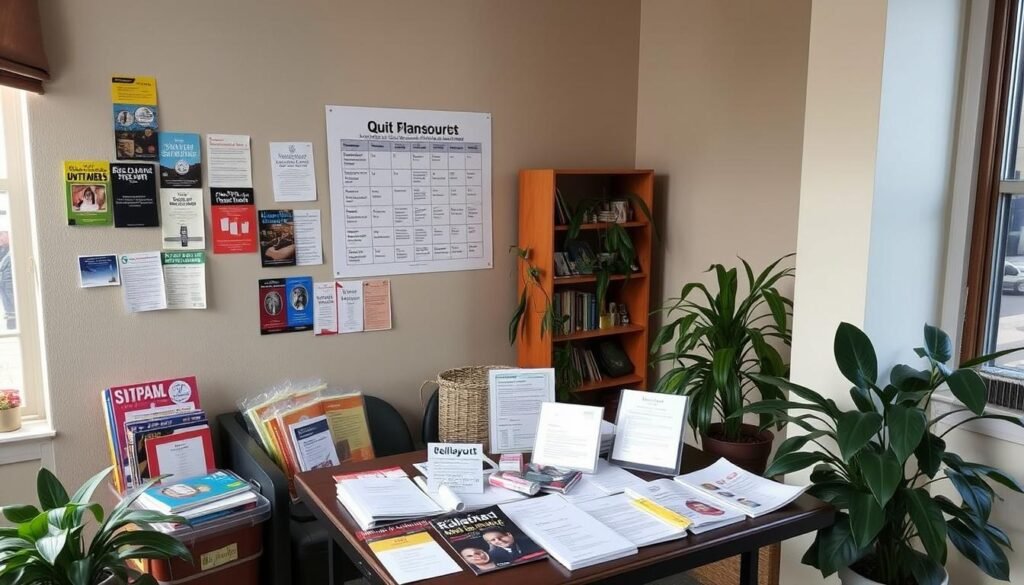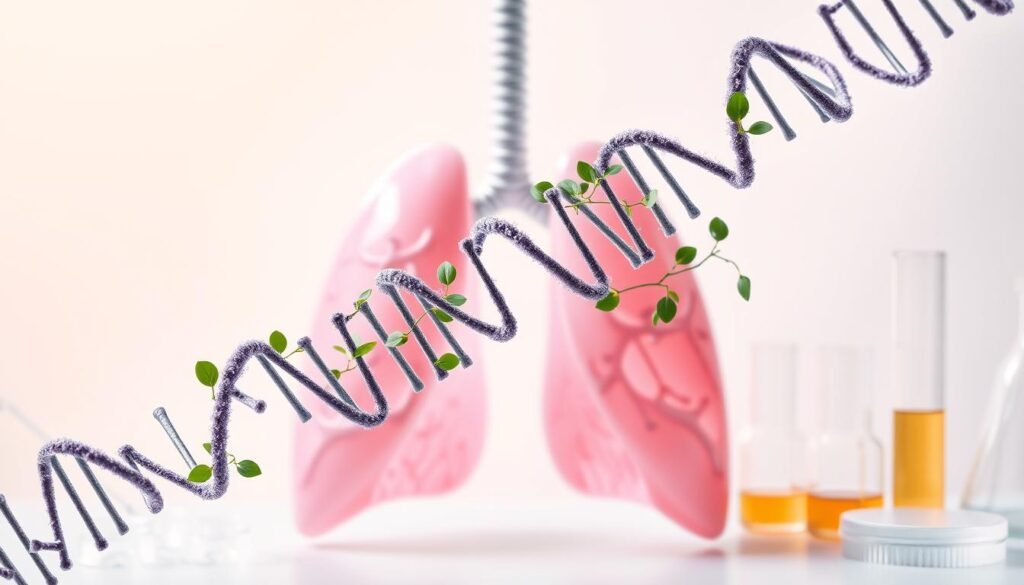Did you know about 85% of lung cancer cases are due to smoking? This shows how important it is to prevent lung cancer. Since lung cancer is a top cause of cancer deaths in the US, acting early can lower your risk.
Avoiding tobacco is key, but there’s more to preventing lung cancer. It involves being aware, catching it early, and making healthy choices. By staying informed and proactive, you can make a big difference in your health. Let’s talk about ways to prevent lung cancer and keep your lungs healthy.
Key Takeaways
- 85% of lung cancer cases are connected to smoking.
- Preventive healthcare is vital in reducing lung cancer risk.
- Awareness and early detection can greatly influence outcomes.
- Healthy lifestyle choices contribute to lung cancer prevention.
- Various resources are available for maintaining lung health.
Understanding Lung Cancer and Its Risks
Lung cancer is a top cancer type in the United States. It comes in two main kinds: small cell and non-small cell. The types affect how doctors approach treatment and patient recovery.
Small cell lung cancer is closely linked to heavy smoking. It grows fast and spreads quickly. Non-small cell lung cancer includes different subtypes like adenocarcinoma and squamous cell carcinoma. It usually grows more slowly, which might increase treatment options.
Knowing lung cancer risks is key for early detection. Smoking is the biggest cause, linked to about 85% of cases. Radon gas, asbestos, and air pollutants also pose risks.
The statistics are alarming. Lung cancer causes more U.S. deaths than any other cancer. Awareness and preventive actions are crucial. They help people find early care, boosting the odds of beating the disease.
| Type of Lung Cancer | Common Characteristics | Growth Rate | Typical Treatment Options |
|---|---|---|---|
| Small Cell Lung Cancer | Associated with smoking, aggressive | Fast | Chemotherapy, Radiation |
| Non-Small Cell Lung Cancer | Varied subtypes, often linked to both smoking and non-smoking factors | Slow to moderate | Surgery, Targeted Therapy, Immunotherapy |
Preventive Healthcare for Lung Cancer
Preventive healthcare is key in the fight against lung cancer. It helps us understand risk factors and the power of early detection. Regular screenings make a big difference.
Taking steps early can greatly lower lung cancer rates.
Importance of Preventive Measures
Preventive measures play a big role in tackling lung cancer. Getting screened regularly can spot problems early. Making lifestyle changes can also reduce risks.
These include eating better and being more active. Being more aware of lung cancer facts helps too. It shows early actions lead to better chances.
Statistics on Lung Cancer Incidence
The stats on lung cancer are eye-opening. It’s still a leading cause of cancer deaths in the US. The American Cancer Society’s data shows trends in lung cancer rates.
Differences exist in how it affects various groups. Lifestyle and preventive care both impact these numbers.
| Demographic | Lung Cancer Incidence Rates (per 100,000) | Year |
|---|---|---|
| Men | 60.7 | 2021 |
| Women | 43.3 | 2021 |
| Age 55-64 | 69.0 | 2021 |
| Age 65+ | 120.5 | 2021 |
Key Risk Factors for Lung Cancer
Knowing what increases the risk of lung cancer is crucial. It helps people make better health decisions. Both the environment and genes matter a lot in figuring out who might get this illness. By understanding these risks, one can focus on how to prevent it.
Environmental Factors
Many things in our surroundings can raise lung cancer risks. Air pollution and toxins are big concerns. Those in cities breathe in pollutants from cars, factories, and cigarette smoke daily. This pollution greatly boosts lung cancer danger, especially for anyone already at risk.
- Air pollution
- Secondhand smoke
- Hazardous materials like asbestos
Studies link these environmental dangers directly to more lung cancer cases. Being around harmful substances a lot can make one more likely to get sick.
Genetics and Family History
Genes also play a role in lung cancer risk. If lung cancer runs in the family, one might have genetic factors that increase their risk. Getting genetic counseling is wise for those with a family history of lung cancer. It helps understand personal risk and find ways to stay healthy.
It’s really important to know your family’s health history. Talking to doctors about it can guide preventive actions and early treatments if needed.
Smoking Cessation: A Vital Step
Stopping smoking is key in fighting lung cancer. It greatly lowers the chance of getting this lethal illness. Besides cutting cancer risk, quitting boosts overall health in many ways.
People who quit smoking see better lung function and heart health. They also face fewer chronic diseases over time. Plus, their quality of life improves significantly.
Benefits of Quitting Smoking
Quitting smoking does wonders for public health, especially by lowering lung cancer rates. The benefits are many:
- Less chance of lung cancer and related diseases.
- Better lung function and easier breathing.
- Fewer medical bills and healthcare costs.
- Improved mental health and happiness.
- A safer environment for loved ones.
Resources for Smoking Cessation
Those ready to stop smoking have many resources to help. Success often depends on getting the right support. Here’s what’s available:
| Resource Type | Description | Examples |
|---|---|---|
| Quitline | A telephone support service offering advice and help. | 1-800-QUIT-NOW |
| Local Support Groups | Meetings with others quitting, for support and tips. | American Cancer Society chapters |
| Online Resources | Websites with quitting tips, forums, and tools. | Smokefree.gov |
| Mobile Apps | Apps to aid your quitting journey. | My QuitBuddy, Quit Genius |
These tools help individuals quit smoking, adding to efforts against lung cancer. They reinforce the good in saying no to cigarettes.

Lung Cancer Screening: The Role of Early Detection
Early detection is key to better outcomes for those at risk for lung cancer. Understanding lung cancer screening guidelines helps identify who should get screened. This is crucial for people aged 50 to 80 who smoked a lot. By detecting lung cancer early, treatments can work better.
Guidelines for Screening
Healthcare providers follow certain guidelines to find who needs lung cancer screening. These guidelines help pick out eligible people. Important points include:
- Age range: 50 to 80 years
- Smoking history: At least 20 pack-year history
- Willingness to undergo timely follow-up diagnostic procedures
This helps doctors and patients make decisions together. It’s about understanding the risks. You can learn more about the criteria by visiting lung cancer screening guidelines.
Benefits of Low-Dose CT Scans
Low-dose CT scans change how we screen for lung cancer. They’re better than old methods at finding early lung cancer. This is crucial for saving lives. Benefits of using low-dose CT scans include:
- Reduction in the likelihood of false negatives
- Ability to identify smaller tumors that might be missed by X-rays
- Lower radiation exposure than regular CT scans
This approach helps catch cancer early when it’s more treatable. For more on early detection, check preventive healthcare resources.
Healthy Lifestyle Choices to Reduce Risk
Choosing a healthy lifestyle is key to lowering your chances of getting lung cancer. Eating well and staying active are important. They help keep your lungs and body strong and healthy.
Importance of Nutrition
Eating right is crucial for your lungs and health. A diet full of fruits, veggies, and grains is best. Choosing these foods boosts your immune system and may cut down on lung cancer risk. Foods with lots of antioxidants, like berries, leafy greens, and nuts, are especially good for you.
Incorporating Physical Activity
Being active is great for your lungs and can reduce cancer risk. Activities like walking, biking, or swimming keep your lungs healthy and improve your overall health. Try to get at least 150 minutes of moderate or 75 minutes of vigorous activity weekly.
| Activity Type | Recommended Duration |
|---|---|
| Walking | 30 minutes, 5 days a week |
| Jogging | 20-30 minutes, 3 days a week |
| Cycling | 30-60 minutes, 2-3 days a week |
| Swimming | 20-40 minutes, 2-3 days a week |
| Strength Training | 20-30 minutes, 2 days a week |

Managing Environmental Risks: Radon and More
Radon is a silent threat that can cause lung cancer. It comes from uranium breaking down in soil, rocks, and water. Homes and buildings can get radon through cracks and gaps around pipes. Knowing about radon helps make the air inside better and lowers lung cancer risk.
Understanding Radon Exposure
It’s important to check homes for radon to keep people safe. Radon can really increase the chance of getting lung cancer. It’s linked to about 21,000 lung cancer deaths every year in the U.S. Using radon test kits and getting professional help if levels are high can make homes safer. The Environmental Protection Agency stresses this for health.
Occupational Hazards and Prevention
Some jobs can also increase lung cancer risk. Jobs in construction, mining, and manufacturing might expose people to harmful substances. Following safety rules at work can help avoid these dangers. Employers need to make sure the air is clean, provide safety gear, and teach about handling dangerous materials safely.
Safety groups push for rules to keep work places safe. Taking care of radon at home and safety at work can cut lung cancer risk. These steps help keep everyone healthier and support efforts to fight lung diseases.
Genetic Testing: Know Your Predisposition
Genetic testing provides insights into lung cancer risks, especially for those with a family history of cancer. It is helpful for people with lung cancer history or certain genetic markers. Through it, inherited mutations that raise lung cancer risk can be found. Then, tailored prevention and early treatment strategies can be designed.
Who Should Consider Genetic Testing?
It’s recommended for several groups:
- Individuals with a significant family history of lung cancer
- Those diagnosed with cancer at a young age
- People exhibiting unusual cancer patterns in their family
Knowing these factors helps individuals gauge their risk of lung cancer better. Guidance from reputable sources helps decide if genetic testing is right. Nevertheless, expert advice is vital throughout this journey.
Understanding the Results
Interpreting genetic test results must be done with care. Not every genetic change means cancer will occur. However, some changes might signal a higher risk of lung cancer. Seeking advice from healthcare experts is crucial. They explain the results and suggest what to do next, like ongoing monitoring or prevention.

For more insights on genetic testing, check out understanding genetic testing for cancer risk. This page underlines the importance of wise genetic information use and the need for professional advice in lung cancer risk management.
Community Resources for Lung Health
Getting the right information and support is key for lung cancer patients. There are many community resources out there. They offer help by supporting lung health and making more people aware of lung cancer. These efforts aim to build support networks. They also give educational chances and fight for patients and their families.
Online and Local Support Groups
Support groups for lung health are very important. They help connect people going through similar struggles. You can find support both online and in person. They allow for the sharing of stories and knowledge about lung cancer. Well-known groups include:
- American Lung Association
- Cancer Support Community
- Lung Cancer Foundation
These organizations don’t just offer support. They also share crucial information on treatments, making healthy changes, and finding helpful community resources.
Accessing Preventive Healthcare Services
Services that prevent disease are vital. They provide screenings and important info for catching and managing lung cancer early. There are many ways to access these services:
- Health insurance plans often cover screenings for those at high risk.
- Local health offices offer help and programs for prevention.
- The Affordable Care Act has made it easier for many people to get healthcare. It makes sure important preventive care is available.
- The National Comprehensive Cancer Network provides preventive service guidelines.
Conclusion
To wrap things up, keeping lung cancer at bay is super important. Throughout this piece, we’ve seen the value of changing our habits. Quitting smoking, eating right, and staying active can lower your risk.
Getting checked regularly and knowing about dangers like radon and job-related risks are key for healthy lungs. There are community resources out there to help. They offer support and access to services that could save your life.
Looking after your lung health isn’t something you do on your own. It takes learning, support, and working together. When we all take steps to prevent it, we help make society’s lungs healthier. By knowing more and doing more, we can beat lung cancer together.